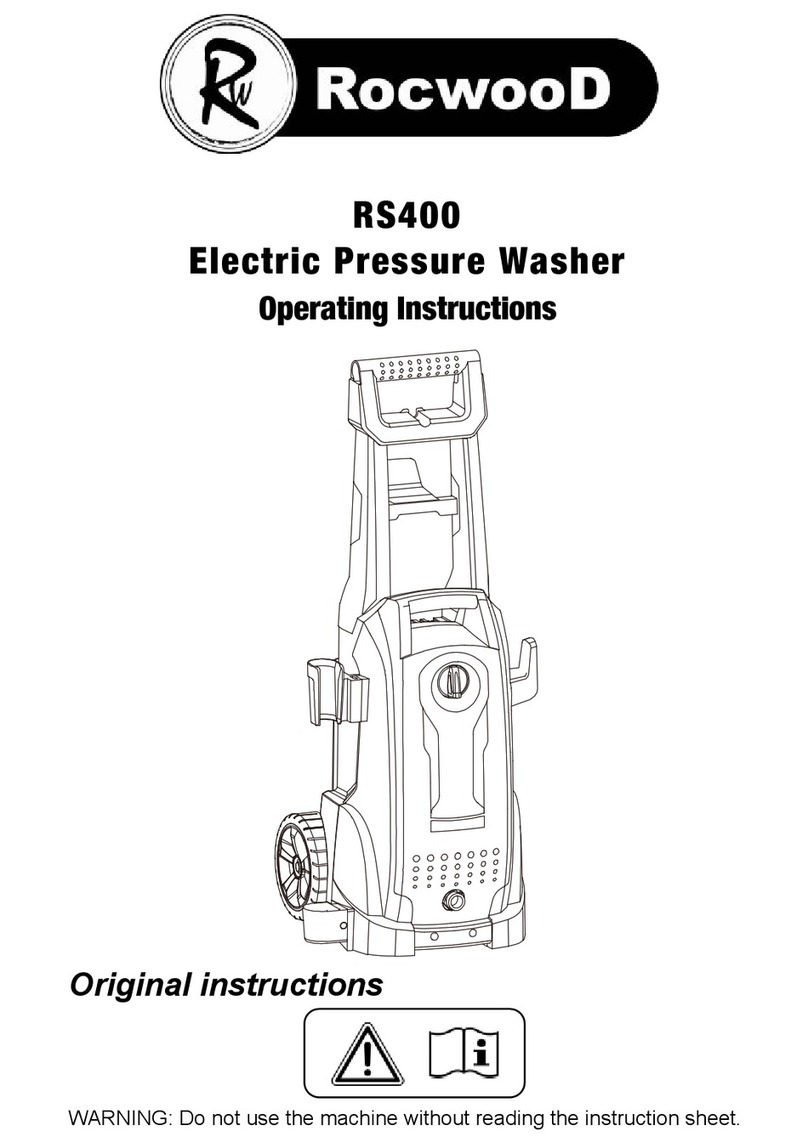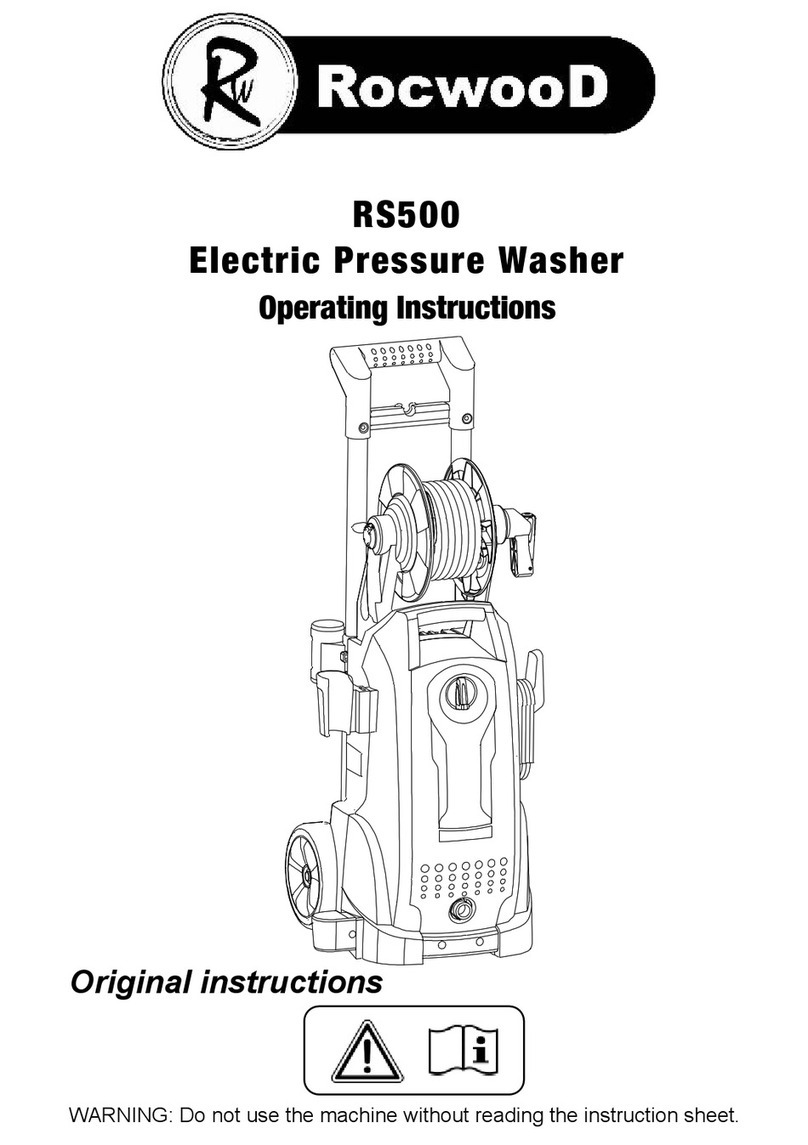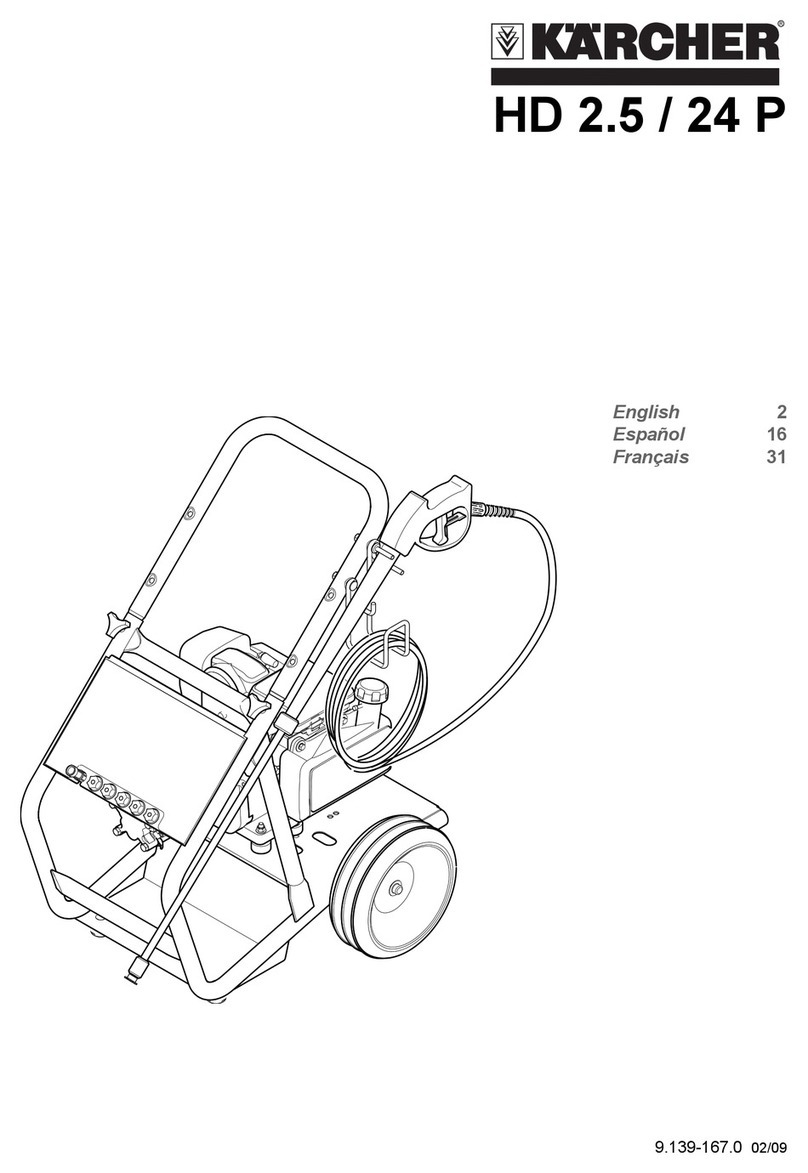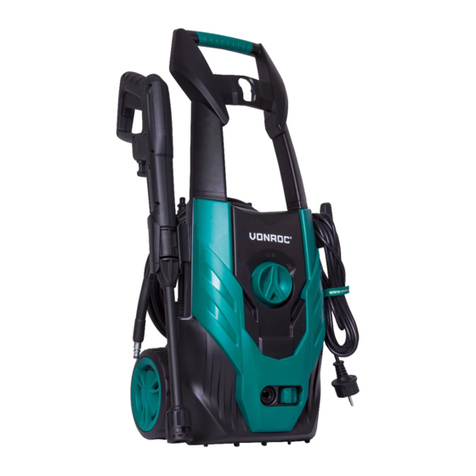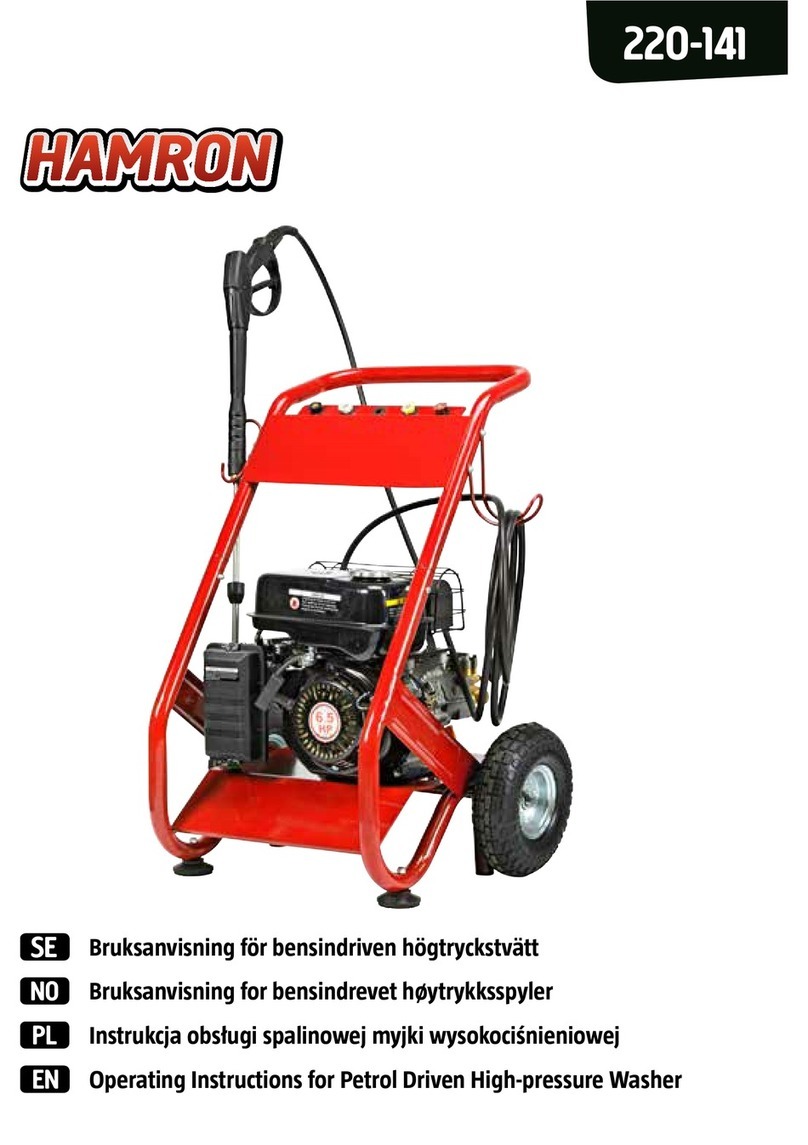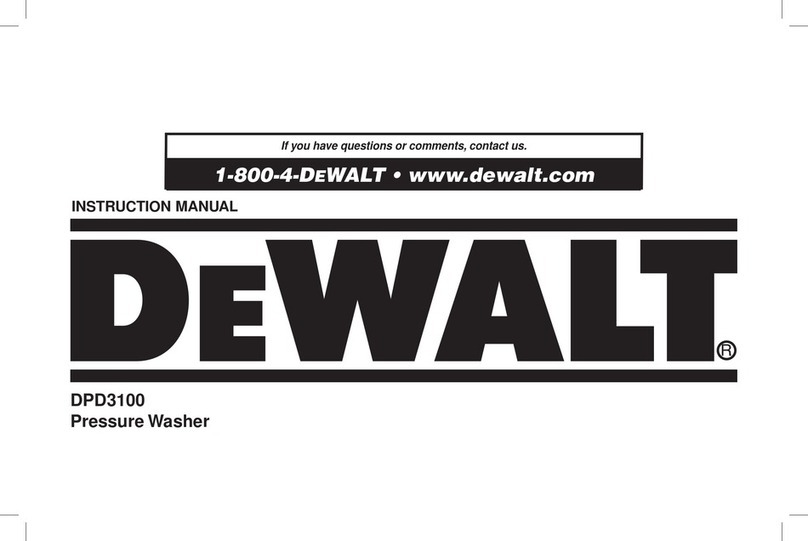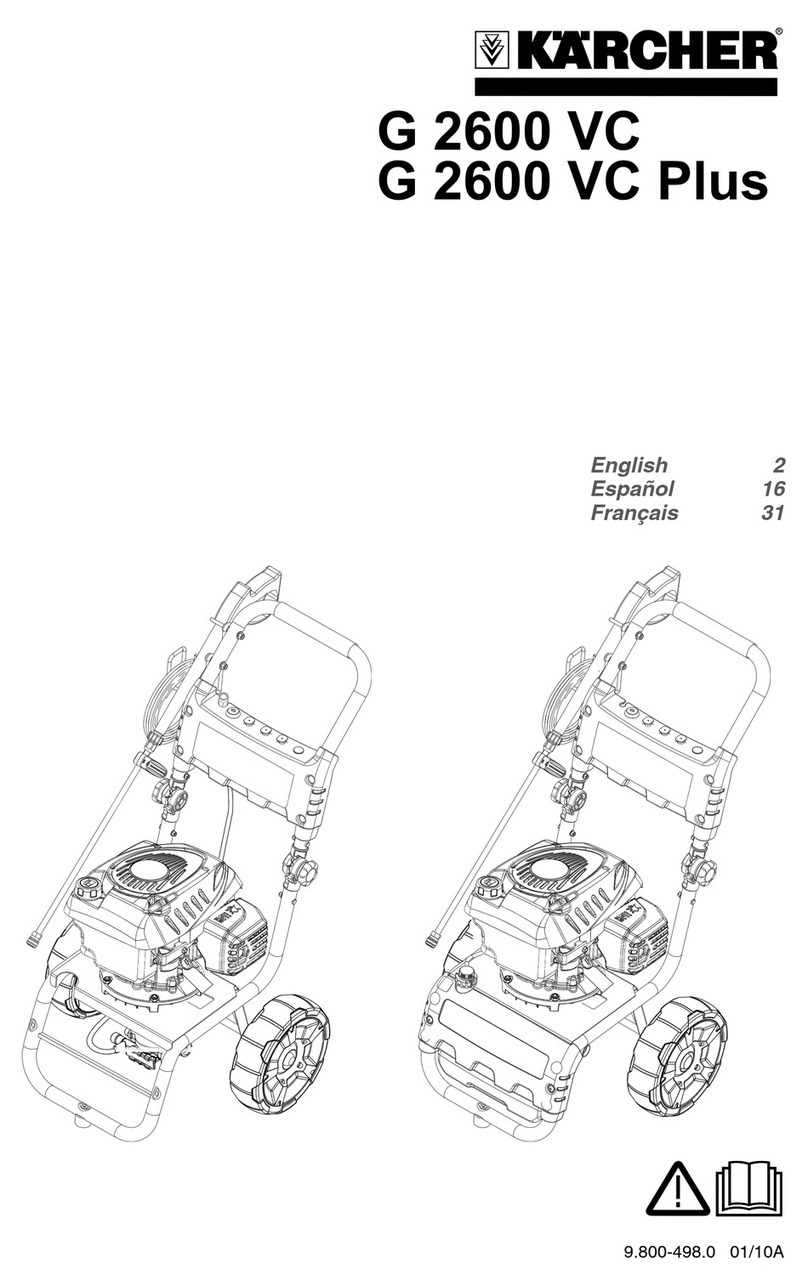RocwooD RWHPPW4 User manual

HIGH POWER
PRESSURE WASHER
RocwooD
Instruction Manual
NOTE: PLEASE READ INSTRUCTIONS CAREFULLY BEFORE USE.
RWHPPW4 &
RWHPPW4ES

• Read instructions carefully before operating this product.
• Keep bystanders away.
• This product is for outdoor use only.
• Ensure the engine is stopped before carrying out adjustments, cleaning or maintenance.
• Always turn o the engine and water supply when nished.
• Do not use the product if found to be damaged.
• Only use with detergents specied by the manufacturer. Other chemicals may compromise the safety of the product.
• Do not direct the pressure jet towards mechanical parts containing lubricant grease.
• Clean vehicle tyres from a minimum of 50cm to avoid damage by the high pressure jet.
• Do not point high pressure jets at people, animals, live electrical parts or the product itself.
• Do not use accessories such as hoses and connections that are not advised by the manufacturer.
• Engage the high pressure safety catch located on the gun when not in use.
• Do not step/stand on the high pressure hose.
• Ensure the nozzle is securely attached before using the Product. High pressure can cause it to be red from the lance with
considerable force, and could cause injury & damage.
• Be ready for the kick-back force and the sudden torque on the spray assembly when operating the trigger.
• A high pressure jet can remove paint and other surface nishes. It can also damage tarmac and grouting.
• Switch o completely when not attended.
• The hose is designed specically for operation with high pressures. Take care to avoid damage that may prevent correct
operation of the product.
• This product is not to be used by children or anyone with reduced capabilities.
• Always completely unwind the high pressure hose prior to operation.
• Make sure that the machine is switched o before unwinding the high pressure hose, and take care not to pull the
machine over.
• Do not let the high pressure hose contact the hot engine exhaust.
• Do not use this product indoors.
• Keep exhaust emissions away from air intakes.
Explanation of the symbols on the appliance!
GENERAL INSTRUCTIONS
WARNING ! Read all the operating instructions
before use!
WARNING! Do not inhale exhaust fumes!
ATTENTION! Hot surfaces! Risk of burns!
Wear protective gloves!
Wear safety shoes!
Wear hearing protection
Wear safety goggles!
High-pressure jets can be dangerous if misused. Do not aim
at people, animals, active electrical equipment or at the
appliance itself .
Regulate engine speed!
Choke:open/close,petrol: on/o
TECHNICAL PARAMETERS:
MODEL: ............................................................RWHPPW4
ENGINE: ............................................................4-STROKE OHV ENGINE
OUTPUT: ..........................................................8HP (5.25 KW)/3600 RPM
DISPLACEMENT: ..........................................196CC
MAXIMUM PRESSURE:...............................3950 PSI (272 BAR)
CONTINUOUS PRESSURE: .......................3000 PSI (207 BAR)
RATED FLOW: ................................................8.5L/MIN
MAX FLOW: ....................................................10L/MIN
MAX WATER TEMPERATURE: ..................60°C

• Do not attempt to modify the product in any way.
• To ensure good operating condition arrange regular servicing from an authorised agent.
• Only use replacement parts supplied by the manufacturer
• Only use fresh,clean and good quality fuel in the engine.
• Never operate the engine without oil.
• Never refuel in close proximity to naked ames, sparks or other sources of ignition e.g. cigarettes.
• Do not refuel when the engine is hot.
• Wipe up and correctly dispose of any fuel spillage immediately with a suitable medium.
• Move away from the refuelling areas before restarting the engine. Store fuel for short periods only in a suitable container
away from heat and direct sunlight.
• Clean the pressure washer thoroughly after each use.
• Regularly check external nuts and xings to ensure vibration caused by normal use has not to begun loosen them
• Remove the spark plug ignition lead from the back of the spark plug and position the lead to avoid accidental
reconnection.
• Store the machine in a secure dry location out of reach of children.
• Empty the fuel tank before storage.
MAINTENANCE AND STORAGE
GETTING TO KNOW YOUR PETROL PRESSURE WASHER
1. Engine 2. Pump 3. Lower Frame
4. Top Handle 5. Frame feet 6. Panel
7. Wheel 8. Soap tank 9. Lance
10. Hand spray gun 11. Nozzle 12. Hose
10
11
9
8
5
4
12
6
1
3
7
2

FIG. 1
ASSEMBLYINSTRUCTIONS
NOTE: Every machine is tested during production, so there may a few drops of water inside the pump assembly
Locate the frame feet on to the
lower frame and secureusing
the nuts and bolts provided
Locatethe panel on to
the upper frame and
secure using the nuts
and bolts provided
TO ASSEMBLE THE WHEELS
(Figs. 2-3):
Ensure the appliance is kept in the
upright position. Insert the axle bar
into the axle support tube on the
lower frame, locate the axle bar with
the locating pin
Fit a wheel to the axle and
secure using the locking nut
provided. Repeat this process
for each wheel.
The upper handle can only be
located in one way.
Insert the upper handle into the
uprights of the lower base and
secure in place using the nuts
and securing dials provided.
WARNING:
The engine is not provided with oil. It is necessary to
ll the unit before starting the engine.
ENGINE OIL (FIG. 7):
WARNING:
The engine is not provided with oil. It is necessary to lltheunit
before starting the engine.The engine has twooil ll points at
the front and back of the engine. Remove the desired cap and ll
with the engine oil speci ed to the upper level mark. Replace the
oil ller cap.
ENGINE REQUIRES
FILLING WITH OIL
BEFORE FIRST USE.
FIG. 5
FIG. 6 FIG. 7
FIG. 4
FIG. 2 FIG. 3

HIGH PRESSURE
CONNECTION
(Figs. 8 - 9):
Connect the high pressure
hose A to the units high
pressure outlet.
INSERTING A NOZZLE
(Fig 10):
To insert a nozzle, pull back
the locking collar at the end
of the lance, insert nozzle
and release the collar. This
will lock the nozzle in place.
Ensure the nozzle is inserted
correctly. If not it can yo ut
and injure personnel or
damage property.
CONNECTING THE HOSE
(Fig 11):
Connect the hose to the wa-
ter inlet connector (Max 20PSI
Max Tempreture 60C) and
turn on the water completely
Connect the high pressure
hose to the trigger B. Insert
the lance C into the trigger.
Press firmly against the spring
tension and twist
the coupling into the locked
position. Insert the required
nozzle by retracting the
coupling at the end of the
lance, ensure the nozzle is
inserted securely
WARNING: The engine is not lled with oil. It is necessary to ll the unit before starting the
engine. The engine will not produce a spark unless sucient oil is inside.
CAUTION: Do not run the engine with high or low oil level as this can cause engine damage.
CAUTION: Only use unleaded gasoline.
CAUTION: Avoid damaging your hose by ensuring it does not touch the hot exhaust during
and after use.
CAUTION: Avoid damaging your pump by ensuring the water supply is clean and free of any
foreign objects.
CAUTION: Inlet water temperature must not exceed 60 C and 20PSI .
CAUTION: Never let the appliance operate for more than 2 minutes with the spray gun in the
closed position.
CAUTION: Never operate the pressure washer with repeated and rapid on and o movements
of the trigger
FIG. 8FIG. 9
FIG. 11
FIG. 10
This manual suits for next models
1
Table of contents
Other RocwooD Pressure Washer manuals

